
7 Moose Facts
Back to Superior Country BlogSuperior Country is home to many wildlife species. Arguably the most impressive being the moose which is the largest extant of the deer family. As calves they are light brown, almost caramel colored. As they mature their coats get darker. Each of their hairs is hollow, the air trapped inside provides insulation from cold or hot air and water as well. A flap of skin called a dewlap hangs from the throat, young mature males often have the largest. Whether you’re touring the region in hopes to capture breathtaking photos of the impressive creature, or are hunting them, Superior Country has an abundant population for all your needs.

A tribute trip to the late Janice Mattichuck through Quetico Provincial Park, Superior Country. – David Jackson
1. Names / Terminology
Alces Alces is the scientific name for the moose.
Mooz is the Ojibwe term for moose .
Élan is the French term for moose .
A young moose is referred to as a calf, or calves if plural.
A female moose is referred to as a cow while a male moose is referred to as a bull.
2. Life Span
Calves are born in between May – June, when they are just a week old they have the ability to out run a human! They are very impressive creatures. The calves are weaned off from their mothers milk at 6 months of age. At a year old the calves get run off by their mothers to set out on their own. By this time, they are still young and have troubles defending themselves against predators.

3. Size
As a calf, they are born weighing at around 30lbs-40lbs and already stand over a meter tall! They are massive creatures right from the get-go in life. Continuing into adulthood, the average adult moose weighs anywhere between 800lbs-1,600lbs, males average out larger than that of female moose. They stand roughly 6 feet tall from the ground to their shoulders, their head towering another 2-3 feet above. The most recognizable feature of moose is their antlers, which also reach astonishing sizes. Only males older than a year have antlers. Each year they’ll begin to regrow them faster and larger after shedding season. However, once they reach senior years, the antler growth begins to reduce. In their prime, bull moose can produce antlers with a 6 foot spread! At this size, the antlers usually weigh about 40lbs!

4. Mating
Moose become sexually mature at 4-5 years old and begin annual mating rituals. Mating season occurs in the fall, in Superior Country they usually go into rut during September. At this time, males are searching for a cow to mate with and avoiding other males if they are smaller than average. This is when the bull moose antlers serve their purpose, they reflect the size and power of the moose, often intimidating other bulls to move on if a cow is nearby. However, if two bull moose of similar size and age cross paths, they’ll fight each other for the cow. They’ll charge at one another, lock antlers and begin a pushing and thrashing battle until one is run off or gets injured, claiming the prize of the cow to mate with. After mating, the bull moose does not hang around with the cow for long, they are mainly solitary animals. The cow will endure a 230 long gestation period and then come May – June will have their calf (or calves as they can have twins!).

5. Diet
The Algonquin term “moose” actually means “twig eater”, with that it is easy to guess what most of their diet consists of. They spend majority of their day eating food or moving to places with more dietary options. They feed on leaves, shrubs, tree roots, bark, plant shoots, aquatic vegetation and of course twigs. Moose are almost constantly eating, requiring an impressive 50lbs of food on average a day! When cows are feeding their calf/calves they need to eat even more in order to get a sufficient amount of food for herself and produce enough milk.
6. Habitat
As mentioned, moose spend a considerable amount of their time eating food or travelling to areas with greater dietary options. They inhabit areas with high foraging options for leaves, shrubs, tree roots, bark and plant shoots, young forests or mature boreal forests are optimal. They try to stick near water sources not only for the water but also for aquatic vegetation, moose love swampy/marshy areas as it is the best of both worlds in term of hydration and consumption. Moose are also excellent swimmers, they can swim great lengths and up to 9km/h! This is especially useful in terms of fleeing predators, crossing lakes from one side to another or to an island with high vegetation.
7. Antler Shedding
Bull moose being growing their antlers in the spring, shortly after they have shed off. They’ll grow throughout the spring, summer and into the fall. As previously mentioned, the fall is the main and really only time the antlers are utilized. The antlers have a velvet coating on them, however, in the fall the velvet will begin peeling off, this does not hurt them at all. They encourage the velvet shed by rubbing their antlers on trees, they instinctively feel the need to rid of them. The antlers will fully come off the moose anytime between November and March, then undergo regrowth again. The shedding of antlers do not hurt the moose whatsoever, honestly, it is probably a temporarily relief having the weight off their head. Lots of people spend time searching for shed from moose and dear both to use while hunting or even as décor.

 Walleye
Walleye Northern Pike
Northern Pike Lake Trout
Lake Trout Brook Trout
Brook Trout Steelhead
Steelhead Salmon
Salmon Smallmouth Bass
Smallmouth Bass Perch
Perch Superior Picnics
Superior Picnics
